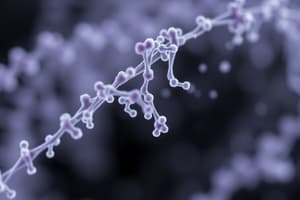Podcast
Questions and Answers
What guides the experimental design and workflow in an RNA-Seq experiment?
What guides the experimental design and workflow in an RNA-Seq experiment?
- The availability of advanced sequencing technology
- The expertise of the lab technician
- The clear and well-defined biological question (correct)
- The number of samples collected
In a two-factor RNA-Seq experiment, how many groups of samples are there if each factor has 3 conditions?
In a two-factor RNA-Seq experiment, how many groups of samples are there if each factor has 3 conditions?
- 3
- 5
- 9 (correct)
- 6
What is the purpose of factorial design in RNA-Seq experiments?
What is the purpose of factorial design in RNA-Seq experiments?
- To detect interacting effects between biological factors (correct)
- To simplify the experimental workflow
- To reduce the number of samples required
- To speed up the data analysis process
What is an example of a straightforward design in RNA-Seq experiments?
What is an example of a straightforward design in RNA-Seq experiments?
In an RNA-Seq experiment, what does a single factor with more than two conditions allow researchers to detect?
In an RNA-Seq experiment, what does a single factor with more than two conditions allow researchers to detect?
Flashcards are hidden until you start studying
Study Notes
Experimental Design in RNA-Seq
- The experimental design and workflow in an RNA-Seq experiment are guided by the research question and experimental objective.
Design and Sample Groups
- In a two-factor RNA-Seq experiment, there are 3 × 3 = 9 groups of samples if each factor has 3 conditions.
Factorial Design
- The purpose of factorial design in RNA-Seq experiments is to investigate the effect of multiple factors and their interactions on gene expression.
- Factorial design allows researchers to identify complex interactions between factors that may influence gene expression.
Simple Design
- A straightforward design in RNA-Seq experiments is one in which a single factor is investigated, with each sample belonging to one of two conditions (e.g., treatment vs. control).
Single Factor with Multiple Conditions
- A single factor with more than two conditions in an RNA-Seq experiment allows researchers to detect dose-response relationships, time-series effects, or other patterns of gene expression.
Studying That Suits You
Use AI to generate personalized quizzes and flashcards to suit your learning preferences.



